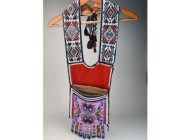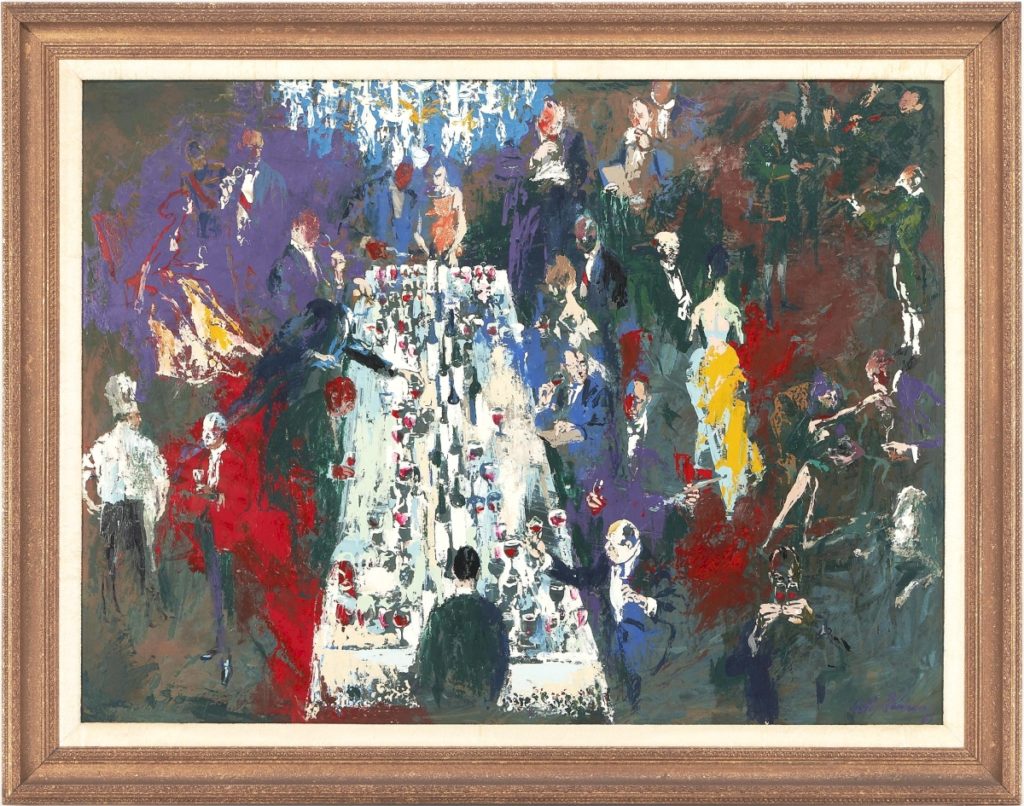
A large LeRoy Neiman (1921-2012) abstract oil on board painting depicting a wine tasting or dinner party with men and women in formal attire gathered around a banquet table, led the sale, bringing $78,000, well above estimate, and going to a collector in the room on the auction’s first day. It was signed and dated “Leroy Neiman ‘65” lower right, measured 35½ by 47 inches and was housed in a carved giltwood frame with an off-white velvet liner.
Review by W.A. Demers, Photos Courtesy Case Antiques
KNOXVILLE, TENN. – Two old Southern family collections, augmented by items from other Southern estates and collections, contributed a time capsule of treasures that crossed the block July 9-10 at Case Auctions. The two-day, 1,200-lot sale, which employed live, phone, absentee and online bidding, included everything from a rare 1830 Native American portrait to an original Leroy Neiman painting, a rare Swiss automaton watch and an important African American quilt.
Items from the estate of Mary Bright Wilson, a former middle Tennessee resident whose family moved from North Carolina and Virginia to settle the area in the late 1700s, were offered as well as those from the Kentucky collection of Peggy Mahoney and Michael Mahoney, whose family tree includes breeders of well-known thoroughbreds and a Confederate general.
A large LeRoy Neiman (1921-2012) abstract oil on board painting depicting a wine tasting or dinner party with men and women in formal attire gathered around a banquet table laden with wine bottles and glasses illuminated by a crystal chandelier led the American paintings, selling for an above-high-estimate $78,000 to a collector in the room on the auction’s first day. Signed and dated “Leroy Neiman ’65” lower right, with remnants of an old gallery label and a newspaper clipping depicting Neiman affixed en verso of frame, the 35½-by-47½-inch painting was housed in a carved giltwood frame with an off-white velvet liner. Neiman was described as the most popular living painter in America during his lifetime. While strikingly original, his work reflected the varied influences of Toulouse-Lautrec, Dufy, the New York Social Realists and the Abstract Expressionists. Probably best known as a portrayer of sporting and social events, he virtually invented the modern genre of sports art and remained its most accomplished and acclaimed practitioner until his death in 2012. The painting came from the estate of Palm Beach and Chattanooga publishing executive Margaret Harold Roberts, Lookout Mountain, Ga.
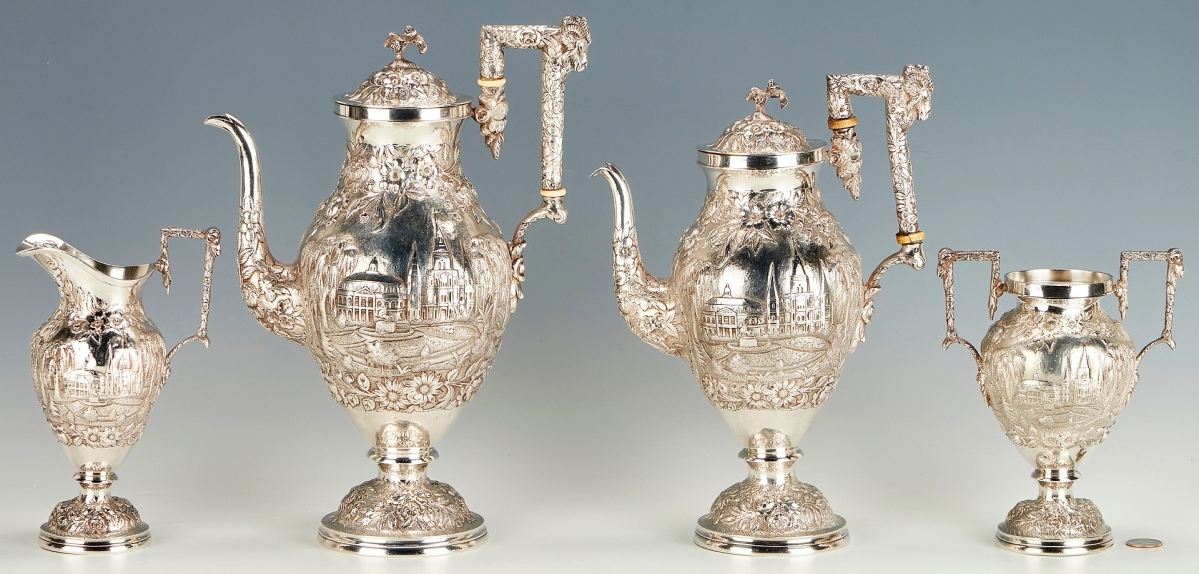
One of the most unusual silver lots in the sale was a rare Nineteenth Century coin silver repousse tea service chased with scenes of New Orleans’ Jackson Square on one side and images of pelicans on the reverse, which sold for $12,000. According to the catalog, the decoration, believed to be unique, is possibly by Bernard Terfloth and Christopf Christian Kuchler (active New Orleans, La., 1858-1866) executed upon an Etruscan pattern tea set with ram’s head handles and repousse floral-decorated lids and feet.
The Wilson collection contributed the second highest selling item, a rare miniature portrait of a Native American brave named Kinheche or Kin-hi-chee, painted in 1830 during a historic summit between Chickasaw leaders and President Andrew Jackson in Franklin, Tenn. The sale’s cataloger noted that among the observers at the event were a prominent local gentleman, Guilford Dudley, and his 22-year-old daughter Caroline. According to family history, Miss Dudley (who may have been an art teacher at a nearby female academy) was so intrigued by Kinheche’s appearance in his tribal garb that she painted his likeness, intending to give it to him, but was advised by the chief not to do so. She died two years later.
The diminutive portrait, 2¾ by 2¼ inches, sold to Colonial Willamsburg for $60,000. The multiple underbidders included two other institutions. Laura Barry, the museum’s Juli Grainger curator of paintings, drawings and sculpture, said “We are thrilled this important likeness is entering our collections.”
South Carolina artist Alice Ravenel Huger Smith (1876-1958) painted a tonalist watercolor Low Country landscape titled “The Silent Watchers,” which realized $43,200, more than triple its high estimate. It depicted two white cranes perched in branches amid a purple and blue-hued treeline. Signed “Alice R. H. Smith” lower right, it bore a printed label with artist name, location, title and original price en verso. It was housed and matted under glass in a giltwood frame and measured 21-3/8 by 15 inches. The buyer got a bonus. Included with the painting was a copy of the limited edition book Alice Ravenel Huger Smith Of Charleston, South Carolina: An Appreciation On The Occasion Of Her Eightieth Birthday From Her Friends, privately published, edition of 800, 1956, which lists this painting as #599, painted 1953 and originally sold to Dr and Mrs Sullivan of Nashville, Tenn.
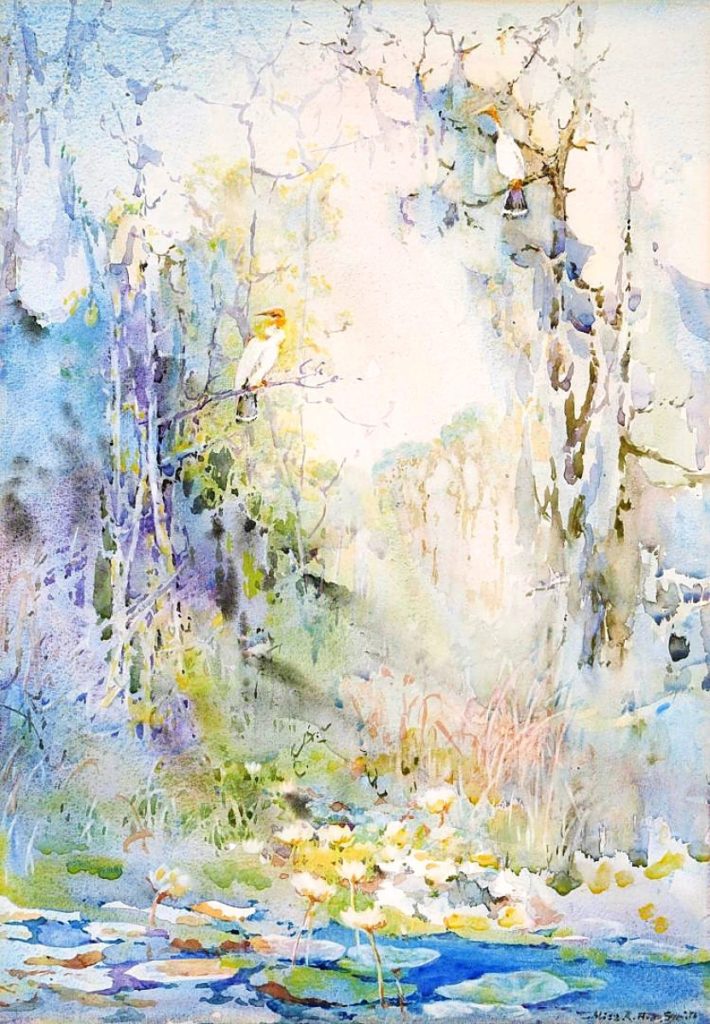
South Carolina artist Alice Ravenel Huger Smith’s (1876-1958) tonalist watercolor Low Country landscape titled “The Silent Watchers,” realized $43,200, more than triple its high estimate.
Smith was largely self-taught and instrumental in the Charleston Renaissance along with friends Elizabeth O’Neill Verner, Alfred Hutty and Anna Heyward Taylor. She served as a founding member of the Charleston Etchers Club and the Southern States Art League and was a part of the Historic Charleston Foundation, Carolina Art Association and the Music and Poetry Society. Her work is included in the permanent collections of the Brooklyn Museum, the High Museum of Art, the Ogden Museum of Southern Art and the de Young Fine Arts Museums of San Francisco, among many others.
Also notable among the fine art presented was a 1963 signed collotype cataloged as after Pablo Picasso. Titled “Le Peintre,” the color collotype and stencil depicted an artist with paint brush, rendered in shades of blue. It brought an above estimate $15,600. It was published by Guy Spitzer, Paris, with blind stamp lower left of image and printed label en verso and was hand signed by Picasso in the lower right margin in blue crayon and numbered 315/350 in pencil, lower left margin. The 33½-by-25½-inch work came from the estate of Ira A. Lipman, Memphis, Tenn.
A rare Swiss automaton pocket watch attributed to Pierre-Simon Gounouilhou (French/Swiss, 1779-1857) brought to life a Dutch kitchen scene. The double open face watch, circa 1805-20, featured a female maid moving a pestle inside a mortar, a dog turning a wheel and vertical spindle connecting to a spit with a rotating chicken and a rotating foil within the fireplace simulating flames. Additional gold elements included a fireplace with pieces of meat hanging above a dog playing with a cat on the floor, next to a basket with vegetables and a broom leaning against a chest. All in an 18K gold surround, the timepiece rose to $31,200. Even its case had a lively presentation with a landscape scene with three men on a riverbank, one man using a mallet, foreground and a small sailboat in the river to the right with a fort like structure and house in the background. Catalog notes state that Gounouilhou was born in France and moved to Geneva, Switzerland, in 1799, becoming a maker of repeating and musical watches, automaton watches and carriage clocks. He worked in partnership with Francois and was one of the few watch and clock makers that produced automaton watches, along with Dubois & Fils. The Patek Philippe Museum has a similar watch in its collection.
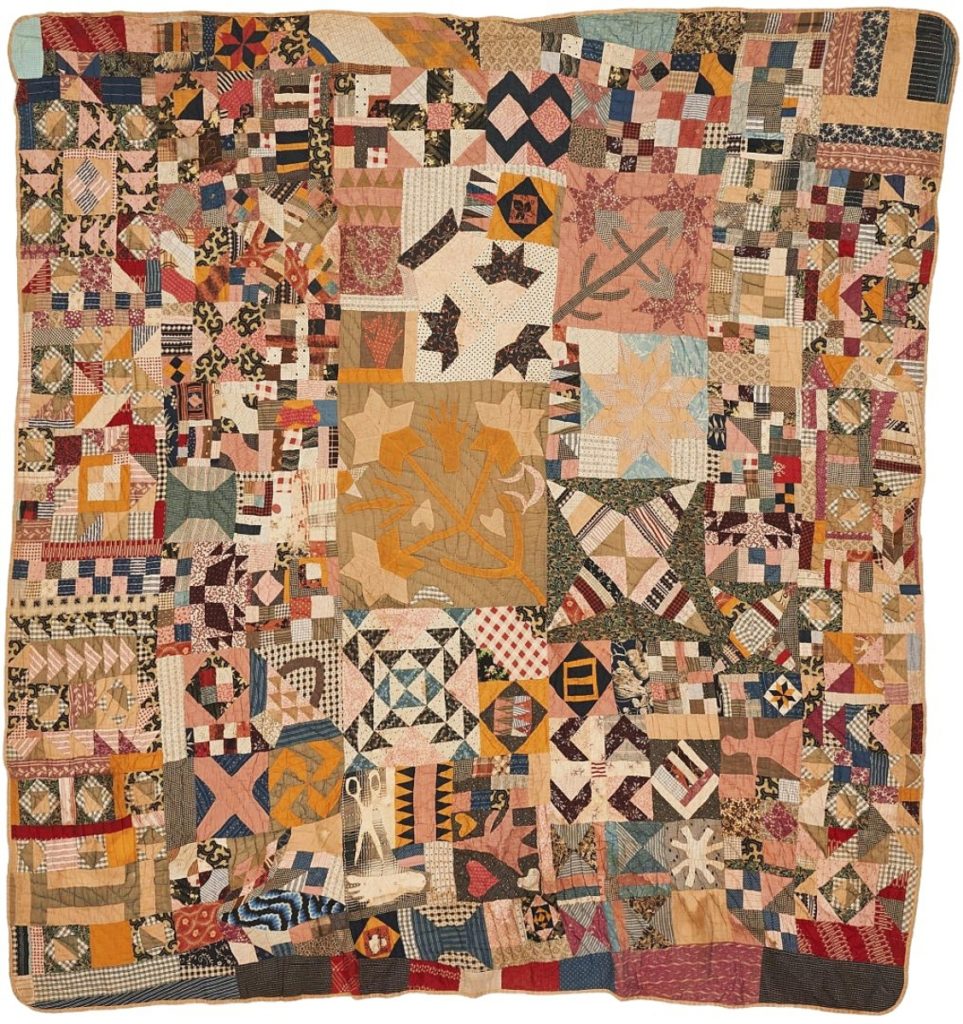
This important African American quilt by Josie Covington (1869-1909) of Triune, Tenn., led the textile offerings at $14,400. The applique quilt featured a number of applique motifs, including star-shaped flowers, pinwheels, scissors and a central hand.
A jewelry highlight came from the Mahoney collection, a lady’s 18K yellow gold and platinum ring featuring a GIA 2.85-carat round brilliant diamond that bettered its high $20,000 estimate to finish at $31,200. With clarity-VS2, color-F, the ring came to the Mahoney collection by descent from the historic homes of Clarkland Farm at Bryan’s Station and Cherrycote, Lexington, Ky. Also from the Mahoney estate was a man’s 18K Rolex Day-Date President wristwatch taking $16,800.
From the estate of Margaret Harold Roberts came a Steinway & Sons Model B grand piano that brought $20,400. It had an ebonized case over tapered legs terminating into block feet and mounted with castors. Its serial #496359 indicated a manufacture date of about 1985, and the lot included a Paul L. Jansen and Son black leather upholstered adjustable bench.
There were more than 150 lots of silver in the auction, including multiple tea sets and numerous pieces of flatware. Tiffany & Co. Audubon sterling silver flatware set for 12 comprising 94 pieces served up $16,640. This pattern, introduced 1871, featured designs of birds inspired by the ornithological paintings of John James Audubon, and the service appeared to date from the mid- to late Twentieth Century. Fetching $14,080 were 130 pieces of Tiffany & Co Chrysanthemum sterling flatware, a service for 12. The Chrysanthemum pattern in the Art Nouveau style was introduced in 1880.
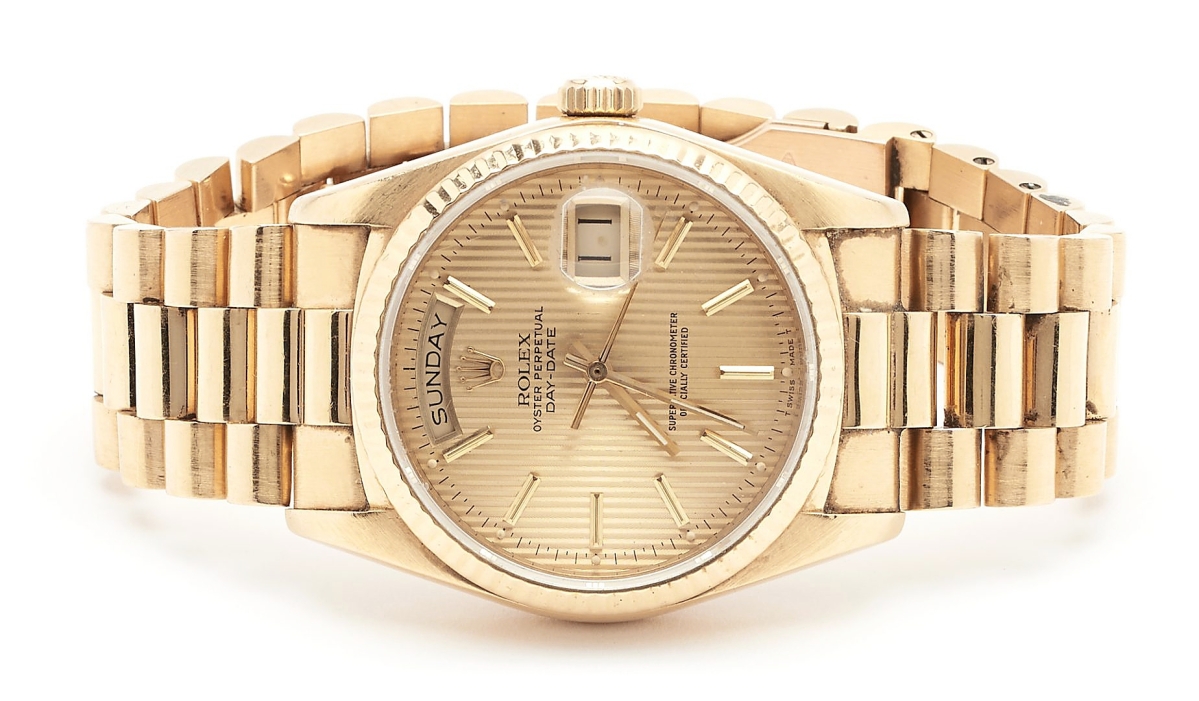
This man’s 18K Rolex Day-Date President wristwatch left the gallery at $16,800.
One of the most unusual silver lots in the sale was a rare Nineteenth Century coin silver repoussé tea service chased with scenes of New Orleans’ Jackson Square on one side and images of pelicans on the reverse, reminiscent of those on the Louisiana state seal. Circa 1858, the set’s scenes depict St Louis Cathedral, the Cabildo and the equestrian statue of General Andrew Jackson on one side and a pelican feeding its young, reminiscent of the Louisiana state seal, on the other side. The catalog notes that the decoration, believed to be unique, is possibly by Bernard Terfloth and Christopf Christian Kuchler (active New Orleans, La., 1858-66) executed upon an Etruscan pattern tea set with ram’s head handles and repoussé floral-decorated lids and feet, either inspired or supplied by a Baltimore maker. It sold for $12,000.
By Stephen Rolfe Powell (1951-2019), a large glass sculpture took $15,600. The untitled work was double lobed and incorporated murine art glass comprising multiple bands of fused colored canes. Standing 31½ inches high, it was signed and dated on one side near the base “Stephen Powell 1995” and initialed BZ.
From a private Tennessee collection was a signed Louis Tiffany Favrile gold iridescent art glass vase with pulled feather design below the rim and to the upper body. The early Twentieth Century piece at 9¾ inches high ignored a $700/900 estimate and was bid to $14,080.
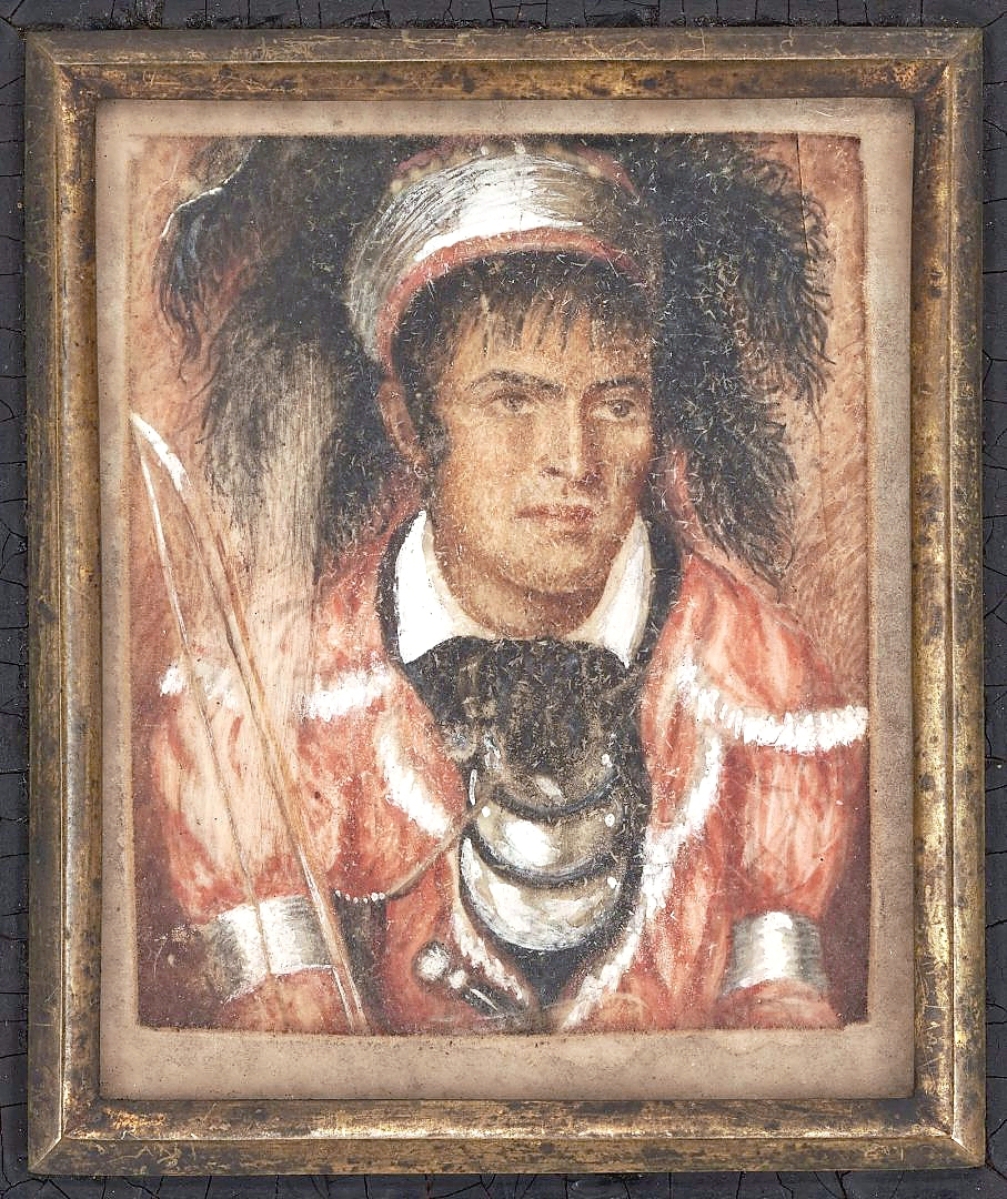
A rare miniature portrait of a Native American brave named Kinheche or Kin-hi-chee, 2¾ by 2¾ inches, painted in 1830 during a historic summit between Chickasaw leaders and President Andrew Jackson in Franklin, Tenn., sold to Colonial Willamsburg for $60,000 vying against multiple underbidders, including two other institutions. “We are thrilled this important likeness is entering our collections,” said Laura Barry, the museum’s Juli Grainger curator of paintings, drawings and sculpture.
A well-documented and exhibited African American quilt led the textile offerings at $14,400. The applique quilt was made by Josie Covington (1869-1909) of Triune, Tenn., and featured a number of applique motifs, including star-shaped flowers, pinwheels, scissors and a central hand. It was included in a traveling exhibition sponsored by the Cleveland Museum of Art and was the cover image for the accompanying catalog. The auction also included a bright pink Hawaiian applique quilt, dated and signed, that leapt from an $800 expectation to earn $12,800.
It was created in two shades of pink cotton or cotton sateen, ink-inscribed en verso to one corner, “1932/Peter Leilani Kaaekuahiwi/From Mother.” The reverse applique on top revealed a lighter coral-colored cloth of the foundation. The quilting thread was yellow and the backing a light coral color. It measured 70 by 80 inches.
While most of the high-selling lots crossed the block on the first day, the sale’s second day had its own surprise when a Twentieth Century Chinese white jade plaque with hardwood stand sold for $26,400 against a $300/350 estimate. With shaped corners and cloud crest, one side depicting a basket of flowers, the plaque’s reverse had raised calligraphy. From the collection of a Nashville physician, the plaque in its stand measured 5 by 3 by 1 inches.
Prices given include the buyer’s premium as stated by the auction house. For information, www.caseantiques.com or 865-558-3033.



















